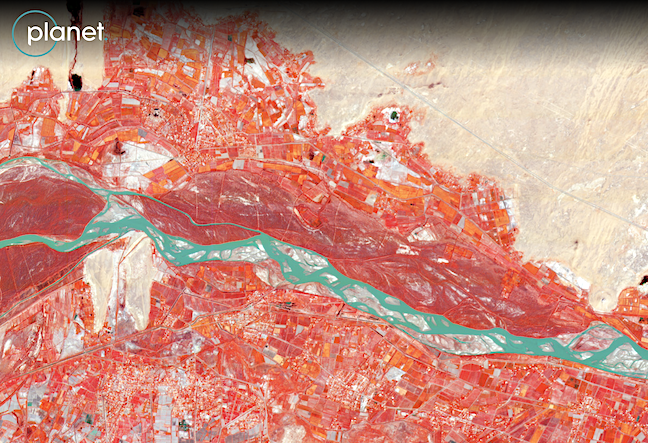Notes taken at the Explore 19 conference by Planet co-founder and CEO Will Marshall reveal the latest product announcements that customers can anticipate in the next year.
Planet Announces More Spectral Bands, 50cm Resolution, Global Analytics, and Change Detection

Next Generation PlanetScope includes more bands, which can help in the study of plant health; it also helps to unlock the potential for advanced analytics. Imagery of Amu Darya, Uzbekistan on September 30, 2019 Credit: Rob Simmon, Planet
This morning at our Planet Monitoring
Will announced new capabilities for Next-Generation PlanetScope, our flagship monitoring solution powered by the latest iteration of our Dove satellite called SuperDove. New sensors are enabling higher image quality with sharper, more vibrant colors and accurate surface reflectance values for advanced algorithms and time-series analysis.
Next-Generation PlanetScope is interoperable with publicly available imagery, like Copernicus Sentinel-2, empowering customers to utilize PlanetScope data with other sensors to enhance their analyses with higher spatial and temporal resolution.
Currently, PlanetScope imagery has four spectral bands (red, green, blue, and near-infrared). Next, Planet will add more spectral bands to enable new applications and use cases.
On stage, Will discussed details about the Next Generation Planetscope, which includes 4-band, 5-band and 8-band PlanetScope imagery powered by SuperDove. Customers can get access to this new 4-band PlanetScope imagery as part of an Early Access Program later in 2019, with 5-band and 8-band imagery made available in early 2020.
Planet Tasking – 50 cm SkySat
Will saved the best for last and introduced Planet’s highest resolution yet: 50cm SkySat imagery.
Planet is building this future capability by lowering the orbit of an existing SkySat and improving image processing to deliver 50 cm data. This new data will open up a wide array of applications in energy, mining, finance, and security, which require ultra-fine resolution to distinguish objects and features.
Planet aims to make this 50 cm imagery available to customers in the first half of 2020.
Planet Analytic Feeds
Planet’s Analytic Feeds are now generally available, allowing any customer to enhance their imagery products by adding Road Detection, Building Detection, or Vessel Detection Feeds. Planet Analytic Feeds use computer vision to automatically identify features of interest in Planet Basemaps and PlanetScope scenes.
For beta release at the end of this year, Change Detection Feeds let customers automatically detect change at global scale and rapid frequency—an unmatched capability. Customers can efficiently locate where change has occurred to help focus where they spend their time, or to tip higher-resolution imagery, like SkySat, to get a closer look. Change Detection Feeds represent the next phase of our analytic capabilities, helping customers focus their resources on where change has recently occurred.
Planet Orbit
To help bring these new product capabilities to market, Will announced Planet Orbit, the revamp of our partner program that helps fuel customer success. Planet Orbit provides partners access to geospatial data unavailable elsewhere in the commercial market, and helps them to grow their business through trainings, tools, joint market activities, strategic collaboration, and more.

